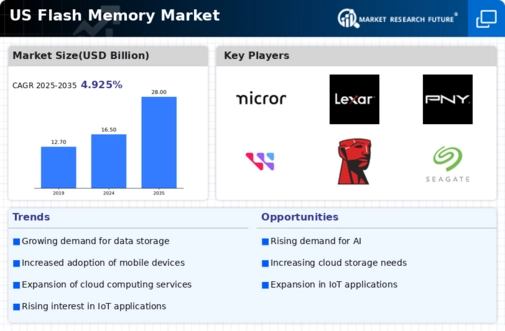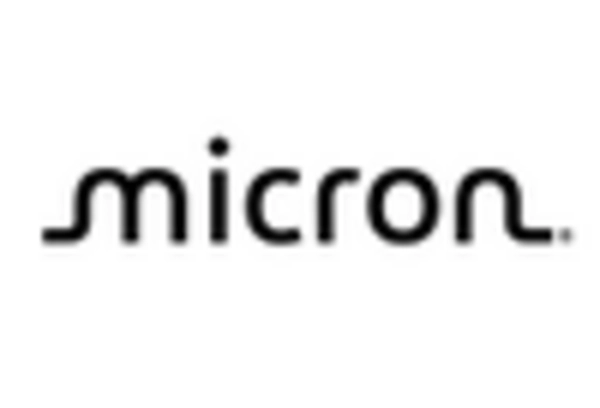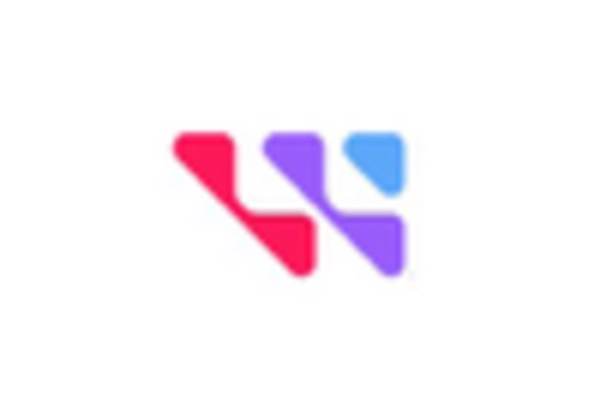Expansion of IoT Applications
The expansion of Internet of Things (IoT) applications is emerging as a pivotal driver for the flash memory market. As more devices become interconnected, the need for efficient data storage solutions becomes increasingly critical. Flash memory is well-suited for IoT devices due to its durability and speed, making it a preferred choice for applications ranging from smart home devices to industrial automation. In 2025, the IoT market is projected to exceed $1 trillion, which will likely bolster the flash memory market as manufacturers seek to provide reliable storage solutions for these devices. The integration of flash memory in IoT applications not only enhances performance but also supports the growing demand for real-time data processing and analytics.
Increased Focus on Data Security
The flash memory market is witnessing an increased focus on data security, which is becoming a critical concern for consumers and businesses alike. As data breaches and cyber threats become more prevalent, the demand for secure storage solutions is rising. Flash memory manufacturers are responding by incorporating advanced encryption technologies and security features into their products. This trend is particularly relevant in sectors such as finance and healthcare, where data integrity is paramount. In 2025, the market for secure storage solutions is expected to grow significantly, further driving the flash memory market. The emphasis on data security not only enhances consumer trust but also positions flash memory as a vital component in safeguarding sensitive information.
Growing Adoption of Cloud Computing
The increasing adoption of cloud computing services is a significant driver for the flash memory market. As businesses and individuals migrate to cloud-based solutions, the demand for efficient and reliable storage solutions rises. Flash memory plays a crucial role in data centers, where speed and reliability are paramount. In 2025, the cloud computing market is anticipated to surpass $500 billion, with a substantial portion allocated to storage solutions. This trend indicates a robust growth trajectory for the flash memory market, as providers seek to enhance their infrastructure with high-performance storage options. Additionally, the scalability offered by flash memory aligns well with the dynamic needs of cloud services, further solidifying its position in the market.
Surge in Consumer Electronics Production
The flash memory market is significantly influenced by the surge in consumer electronics production. With the proliferation of smartphones, tablets, and wearable devices, the demand for high-capacity storage solutions is escalating. In 2025, the consumer electronics market is projected to reach $1 trillion, with flash memory being a critical component in these devices. Manufacturers are increasingly integrating flash memory to meet consumer expectations for speed and storage capacity. This trend is likely to drive innovation within the flash memory market, as companies strive to produce smaller, faster, and more efficient memory solutions. The continuous evolution of consumer electronics is expected to sustain the growth of the flash memory market, creating opportunities for manufacturers and suppliers alike.
Technological Advancements in Flash Memory
The flash memory market is experiencing rapid technological advancements that enhance performance and efficiency. Innovations such as 3D NAND technology have significantly increased storage density, allowing for higher capacity in smaller form factors. This trend is particularly relevant in the consumer electronics sector, where devices demand more storage without compromising size. In 2025, the market is projected to reach approximately $50 billion, driven by these advancements. Furthermore, the introduction of faster interfaces, such as NVMe, is likely to improve data transfer rates, making flash memory more appealing for high-performance applications. As technology continues to evolve, the flash memory market is expected to adapt, catering to the growing needs of various sectors, including mobile devices, laptops, and data centers.
















Leave a Comment